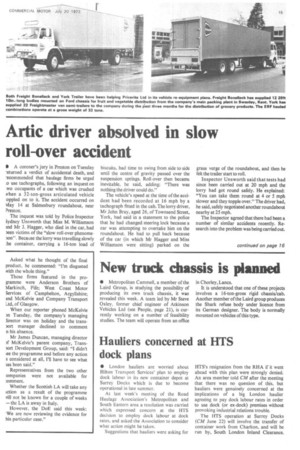Artic driver absolved in slow roll-over accident
Page 17

Page 18

If you've noticed an error in this article please click here to report it so we can fix it.
• A coroner's jury in Preston on Tuesday -eturned a verdict of accidental death, and 'ecommended that haulage firms be urged Ja use tachographs, following an inquest on wo occupants of a car which was crushed when a 32-ton-gross articulated vehicle .oppled on to it. The accident occurred on Vlay 14 at Salmesbury roundabout, near ?reston.
The inquest was told by Police Inspector Sydney Unsworth that Miss M. Williamson Ind Mr J. Hagger, who died in the car, had )een victims of the "slow roll-over phenometon". Because the lorry was travelling slowly :he container, carrying a 16-ton load of biscuits, had time to swing from side to side until the centre of gravity passed over the suspension springs. Roll-over then became inevitable, he said, adding: "There was nothing the driver could do."
The vehicle's speed at the time of the accident had been recorded at 16 mph by a tachograph fitted in the cab. The lorry driver, Mr John Bray, aged 26, of Townsend Street, York, had said in a statement to the police that he had changed steering lock because a car was attempting to overtake him on the roundabout. He had to pull back because of the car (in which Mr Hagger and Miss Williamson were sitting) parked on the grass verge of the roundabout, and then he felt the trailer start to roll.
Inspector Unsworth said that tests had since been carried out at 20 mph and the lorry had got round safely. He explained: "You can take them round at 4 or 5 mph slower and they topple over." The driver had, he said, safely negotiated another roundabout nearby at 25 mph.
The Inspector agreed that there had been a number of similar accidents recently. Research into the problem was being carried out.
The operators of the vehicle involved in the Preston accident are Wilson's Transport Ltd, of Boroughbridge, Yorks, and Mr Nigel Wilson told CM this week that this was the first incident of this nature in which one of their vehicles had been involved. The outfit was a Volvo F88 with a 40ft trailer carrying a 40ft container. The driver, he said, was a "very careful" man with five years' experience on artics, including incident-free mileage on the Continent.
His company was in favour of tachographs both for fleet control and a check on driving hours and — as this incident had clearly demonstrated — as a protection for drivers.
Wilson's fitted time recorders on their vehicles from 1963 but the 10 vehicles taken into the fleet since 1970 have all been fitted with Lucas-Kienzle tachographs. Record discs are checked every week.
Lucas-Kienzle were asked to analyse the disc on the accident vehicle and check the instrument itself, which was found to be accurate; this was especially important because it is understood that at least one eyewitness had claimed that the artic was travel
ling at 30 mph.
CM's Technical Editor writes: In its summing up, the Preston coroner's jury recommended that the dangers associated with articulated lorries on roundabouts should be highlighted by the DoE. As readers of CM will know, the DoE is well aware of the problem, as are the research institutes.
CM last week reported papers given at a conference on vehicle safety at Cranfield, one of which discussed the low roll-over speed of some artics. That paper was concerned with roll-over caused by excessive speed, but the Cranfield Institute of Technology has pointed out the possibility of roll-over occurring at a speed lower than that critical speed, when the vehicle roll frequency (on its suspension) coincides with the rate at which the vehicle is changing direction. This is exactly the situation which a driver can encounter at a roundabout and is the point made by Inspector Unsworth at the inquest.
The Transport and Road Research Laboratory, however, disagrees with this theory, and much more experimental work needs to be done before the problems of rollover at roundabouts are resolved.




































































































